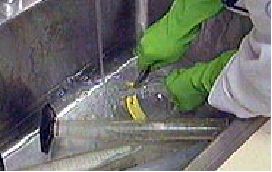| Glassware Washing Hazards |

|
|
1 - Glassware Washing Hazards
2 - Page 2 3 - Page 3 |

 HOME
HOMEGood laboratory technique demands clean glassware, because the most carefully executed piece of work may give an erroneous result if dirty glassware is used. In all instances, glassware must be physically clean; it must be chemically clean; and in many cases, it must be bacteriologically clean or sterile.
The video provided below demonstrates skillful glassware washing and sterilization techniques. The video stresses the importance of proper glassware washing to good science, promotes the use of personal protective equipment and encourages teamwork and good work habits.
 |
![]() Glassware Washing in Quicktime Movie
Glassware Washing in Quicktime Movie
RunningTime: 10 minutes
Cleaning
Wash labware as quickly as possible after use. If a thorough cleaning is not possible immediately, soak glassware in water.
Most new glassware is slightly alkaline in reaction. For precision chemical tests, new glassware should be soaked several hours in acid water (a 1% solution of hydrochloric or nitric acid) before washing.
Brushes with wooden or plastic handles are recommended as they will not scratch or abrade the glass surface.
Glassware Cleaners
When washing, soap, detergent, or cleaning powder (with or without an abrasive) may be used. The water should be hot. For glassware that is exceptionally dirty, a cleaning powder with a mild abrasive action will give more satisfactory results. The abrasive should not scratch the glass.
Scratched glass is more prone to break during experiments, especially when the glass is heated. Do not allow acid to come into contact with a piece of glassware before the detergent (or soap) is thoroughly removed. If this happens, a film of grease may be formed.
Safe Use of Chromic Acid
If glassware becomes unduly clouded or dirty or contains coagulated organic matter, it must be cleansed with chromic acid cleaning solution. The dichromate should be handled with extreme care because it is a powerful corrosive and carcinogen.
When chromic acid solution is used the item may be rinsed with the cleaning solution or it may be filled and allowed to stand. The length of time it is allowed to stand depends on the amount of contamination on the glassware. Relatively clean glassware may require only a few minutes of exposure; if debris is present, such as blood clots, it may be necessary to let the glassware stand all night. Due to the intense corrosive action of the chromic acid solution, it is good practice to place the stock bottle, as well as the glassware being treated, in flat glass pans or pans made from lead or coated with lead, or plastic polymer pans determined compatible with the concentration of chromic acid you are using. Extra care must be taken to be sure chromic acid solution is disposed of properly.
Removing Grease
Grease is best removed by boiling in a weak solution of sodium carbonate. Acetone or any other fat solvent may be used. Strong alkalis should not be used. Silicone grease is most easily removed by soaking the stopcock plug or barrel for 2 hours in warm decahydronaphthalene.
Drain and rinse with acetone. Be sure to rinse off all of the cleaning agents.
Rinsing
It is imperative that all soap, detergents and other cleaning fluids be removed from glassware before use. This is especially important with the detergents, slight traces of which will interfere with serologic and cultural reactions.
After cleaning, rinse the glassware with running tap water. When test tubes, graduates, flasks and similar containers are rinsed with tap water, allow the water to run into and over them for a short time, then partly fill each piece with water, thoroughly shake and empty at least six times. Pipets and burets are best rinsed by attaching a piece of rubber tubing to the faucet and then attaching the delivery end of the pipets or burets to a hose, allowing the water to run through them. If the tap water is very hard, it is best to run it through a deionizer before using.
Rinse the glassware in a large bath of distilled water. Rinse with distilled water. To conserve distilled water, use a five gallon bottle as a reservoir. Store it on a shelf near your clean-up area. Attach a siphon to it and use it for replenishing the reservoir with used distilled water.
For sensitive microbiologic assays, meticulous cleaning must be followed by rinsing 12 times in distilled water.
Handling and Storing
To prevent breakage when rinsing or washing pipets, cylinders or burets, be careful not to let tips hit the sink or the water tap.
Dry test tubes, culture tubes, flasks and other labware by hanging them on wooden pegs or placing them in baskets with their mouths downward and allowing them to dry in the air; or place them in baskets to dry in an oven. Drying temperatures should not exceed 140?C. Line the drying basket with a clean cloth to keep the vessel mouths clean.
Dry burets, pipets and cylinders by standing them on a folded towel. Protect clean glassware from dust. This is done best by plugging with cotton, corking, taping a heavy piece of paper over the mouth or placing the glassware in a dust-free cabinet.
Store glassware in specially designed racks. Avoid breakage by keeping pieces separated.
Do not store alkaline liquids in volumetric flasks or burets. Stoppers or stopcocks may stick.
| [1] 2 3 Next >> |
